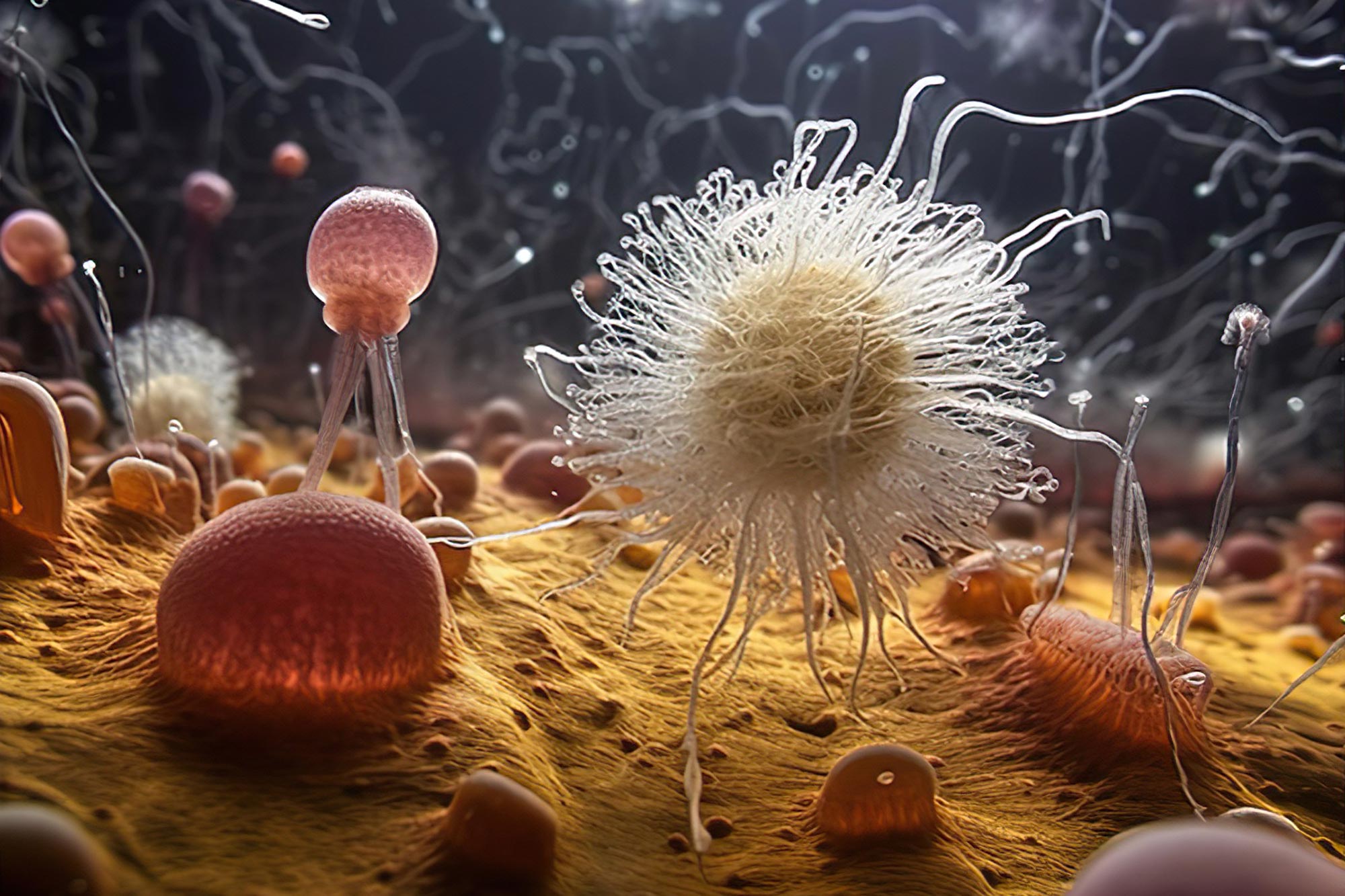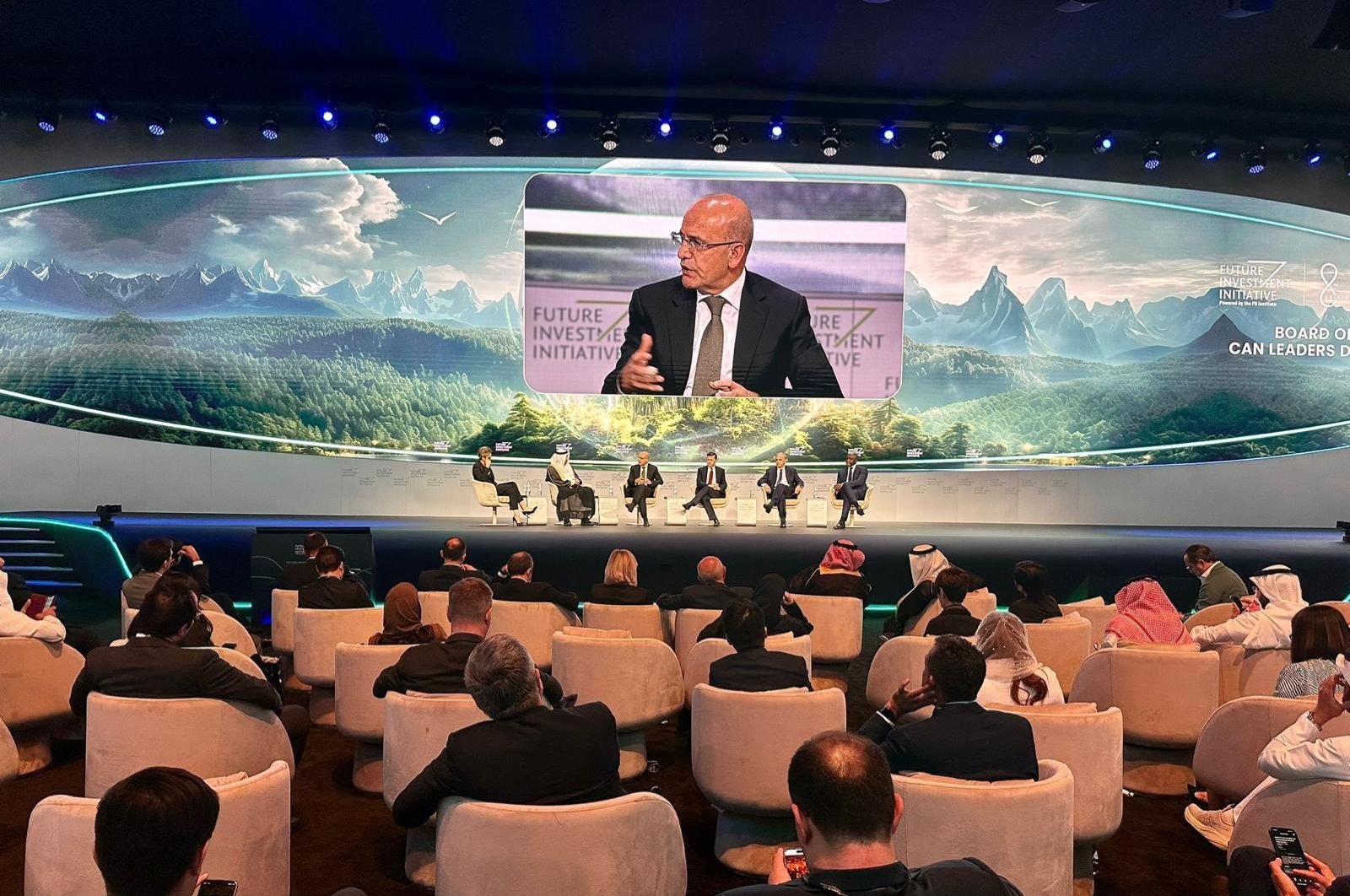
ile
Sanatçının, okyanus tabanındaki bir bakteri örtüsü üzerinde yaşayan “Protosterol Biota”dan bir grup ilkel ökaryot hayali. Moleküler fosillere dayanarak, Protosterol Biota organizmaları yaklaşık 1,6 ila 1,0 milyar yıl önce okyanuslarda yaşamış ve bilinen en eski atalarımızdır. Kredi: TA 2023 tarafından MidJourney’de düzenlendi
Çok uluslu bir araştırma ekibi, kayalarda karmaşık yaşamın 1,6 milyar yıl öncesine kadar var olduğunu gösteren antik protosteroidler buldu. Bu moleküller, karmaşık yaşamın evrimi hakkında yeni bilgiler sağlıyor ve geleneksel ve lipid fosil kayıtları arasındaki tutarsızlıkları uzlaştırıyor.
Sözde protosteroidlerin yeni keşfedilen kaydının, Dünya’nın Orta Çağı boyunca şaşırtıcı derecede bol olduğu ortaya çıktı. İlkel moleküller, ökaryotların karmaşıklığının erken bir aşamasında üretildi – mevcut fosil sterol kaydını 800 ve hatta 1.600 milyon yıl öncesine kadar genişletti. Ökaryotlar, tüm hayvanları, bitkileri ve algleri içeren yaşam krallığına verilen bir terimdir ve bakterilerden çekirdek içeren karmaşık bir hücresel yapıya ve daha karmaşık bir moleküler mekanizmaya sahip olmasıyla ayrılır.
Potsdam’daki Alman Yerbilimleri Araştırma Merkezi’nden (GFZ) ortak bilim adamlarından biri olan Christian Hollmann, “Bu keşfin öne çıkan özelliği, ökaryotların mevcut moleküler kaydının basit bir uzantısı değildir” diyor. “Biz insanlar da dahil olmak üzere tüm modern ökaryotların son ortak atasının muhtemelen ‘düzenli’ modern steroller üretebildiği göz önüne alındığında, bu nadir imzalardan sorumlu ökaryotların filogenetik ağacın gövdesine ait olması muhtemeldir.”

Çalışmanın baş yazarlarından biri olan Benjamin Nettersheim, MARUM’daki Jeobiyolojik Moleküler Görüntüleme Laboratuvarında analiz edilen 1.64 milyar yıllık kaya örneklerinin süper çözünürlüklü elemental ve moleküler haritalarını inceliyor. Kredi: MARUM – Deniz Ekolojisi Merkezi, Bremen Üniversitesi; Descamps’ta
Bu “kütük”, ökaryotların tüm canlı dallarının öncüsü olan ortak ata soyunu temsil eder. Temsilcilerinin nesli çoktan tükendi, ancak doğalarına ilişkin ayrıntılar, karmaşık yaşamın evrimini çevreleyen koşullara daha fazla ışık tutabilir. Protosteroidlerin yüzde kaçının nadir bir bakteri kaynağına sahip olabileceğini değerlendirmek için daha fazla araştırmaya ihtiyaç duyulsa da, bu yeni moleküllerin keşfi, yalnızca geleneksel fosillerin jeolojik kayıtlarını fosil yağ moleküllerininkiyle uzlaştırmakla kalmıyor, aynı zamanda dünyaya nadir ve benzeri görülmemiş bir bakış sunuyor. .eski hayattan kayıp. Yaklaşık 800 milyon yıl önce modern fosil stromalların ilk ortaya çıkışıyla belirginleşen, kök gruplu ökaryotların rekabetçi ölümü, giderek daha karmaşık hale gelen yaşamın evrimindeki en kalıcı olaylardan birini yansıtıyor olabilir.
Jochen Brooks ile çalışmayı ilk kez yazan Bremen Üniversitesi Marom’dan Benjamin Nittersheim ekliyor.[{” attribute=””>Australian National University (ANU) – “due to potentially adverse health effects of elevated cholesterol levels in humans, cholesterol doesn’t have the best reputation from a medical perspective. However, these lipid molecules are integral parts of eukaryotic cell membranes where they aid in a variety of physiological functions. By searching for fossilized steroids in ancient rocks, we can trace the evolution of increasingly complex life.”

Dr. Nettersheim inserts a thin section and rock slices of 1.64 billion-years old rocks into the 7T solariX XR FT-ICR-MS equipped with a MALDI source at the Geobiomolecular Imaging Laboratory at MARUM. As part of ongoing research into mid-Proterozoic biomarker signatures at MARUM, GFZ and the Australian National University, Dr. Nettersheim aims to zoom into the cradle of eukaryotic life in unprecedented resolution. Credit: MARUM – Center for Marine Environmental Sciences, University of Bremen; V. Diekamp
Nobel laureate Konrad Bloch had already speculated about such a biomarker in an essay almost 30 years ago. Bloch suggested that short-lived intermediates in the modern biosynthesis of steroids may not always have been intermediates. He believed that lipid biosynthesis evolved in parallel with changing environmental conditions throughout Earth history. In contrast to Bloch, who did not believe that these ancient intermediates could ever be found, Nettersheim started searching for protosteroids in ancient rocks that were deposited at a time when those intermediates could actually have been the final product.
But how to find such molecules in ancient rocks? “We employed a combination of techniques to first convert various modern steroids to their fossilized equivalent; otherwise, we wouldn’t have even known what to look for,” says Jochen Brocks. Scientists had overlooked these molecules for decades because they do not conform to typical molecular search images. “Once we knew our target, we discovered that dozens of other rocks, taken from billion-year-old waterways across the world, were oozing with similar fossil molecules.”
The oldest samples with the biomarker are from the Barney Creek Formation in Australia and are 1.64 billion years old. The rock record of the next 800 million years only yields fossil molecules of primordial eukaryotes before molecular signatures of modern eukaryotes first appear in the Tonian period. According to Nettersheim “the Tonian Transformation emerges as one of the most profound ecological turning points in our planet´s history“. Hallmann adds that “both primordial stem groups and modern eukaryotic representatives such as red algae may have lived side by side for many hundreds of millions of years”. During this time, however, the Earth’s atmosphere became increasingly enriched with oxygen – a metabolic product of cyanobacteria and of the first eukaryotic algae – that would have been toxic to many other organisms. Later, global “Snowball Earth” glaciations occurred and the protosterol communities largely died out. The last common ancestor of all living eukaryotes may have lived 1.2 to 1.8 billion years ago. Its descendants were likely better able to survive heat and cold as well as UV radiation and displaced their primordial relatives.
“Earth was a microbial world for much of its history and left few traces,” Nettersheim concludes. Research at ANU, MARUM and GFZ continues to pursue tracing the roots of our existence – the discovery of protosterols now brings us one step closer to understanding how our earliest ancestors lived and evolved. Shooting at the ancient rocks with a laser coupled to an ultra-high resolution mass spectrometer in MARUM’s globally unique Geobiomolecular Imaging Laboratory, Dr. Nettersheim and his international collaborators aim at zooming into the cradle of eukaryotic life in unprecedented resolution to further improve our understanding of our early ancestors in the future.
Reference: “Lost world of complex life and the late rise of the eukaryotic crown” by Jochen J. Brocks, Benjamin J. Nettersheim, Pierre Adam, Philippe Schaeffer, Amber J. M. Jarrett, Nur Güneli, Tharika Liyanage, Lennart M. van Maldegem, Christian Hallmann and Janet M. Hope, 7 June 2023, Nature.
DOI: 10.1038/s41586-023-06170-w
Participating Institutions:
- Research School of Earth Sciences, The Australian National University, Canberra, Australia
- MARUM – Center for Marine Environmental Sciences, University of Bremen, Bremen, Germany
- Faculty of Geosciences, University of Bremen, Bremen, Germany
- Université de Strasbourg, CNRS, Institut de Chimie de Strasbourg, Strasbourg, France
- Northern Territory Geological Survey, Darwin, Australia
- German Research Center for Geosciences (GFZ), Potsdam, Germany
MARUM produces fundamental scientific knowledge about the role of the ocean and the ocean floor in the total Earth system. The dynamics of the ocean and the ocean floor significantly impact the entire Earth system through the interaction of geological, physical, biological and chemical processes. These influence both the climate and the global carbon cycle, and create unique biological systems. MARUM is committed to fundamental and unbiased research in the interests of society and the marine environment, and in accordance with the Sustainable Development Goals of the United Nations. It publishes its quality-assured scientific data and makes it publicly available. MARUM informs the public about new discoveries in the marine environment and provides practical knowledge through its dialogue with society. MARUM cooperates with commercial and industrial partners in accordance with its goal of protecting the marine environment.

“Bedava müzik aşığı. Sert yemek fanatiği. Troublemaker. Organizatör. Bacon fanatiği. Zombi aşığı. Seyahat bilimcisi.”




More Stories
Lejyonerler bu özel lüks özellikle bağlantılı iki ayrı yolculuğa çıkıyor: rapor
120 yıllık büyümenin ardından Japon bambusu yeni çiçek açıyor ve bu bir sorun
SpaceX, 30 Ekim’de Kaliforniya’dan 20 Starlink İnternet uydusunu fırlatacak